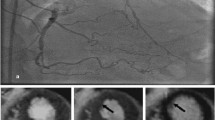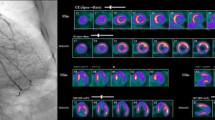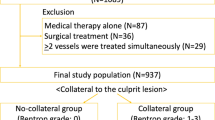Abstract
The success rate of percutaneous coronary artery intervention (PCI) of chronic total occlusion (CTO) lesions have increased in the recent years. However, improvement of function is only possible when significant myocardial viability is present. One of the most important factors of maintaining myocardial viability is the opening and development of collaterals. Our hypothesis was that with a higher degree of collaterals more viable myocardium is present. In 38 patients we compared the degree of collaterals, evaluated with a conventional coronary angiogram (CCA) and graded by the Rentrop classification to transmural extent of the scar obtained in a viability study with magnetic resonance (MRI). We found a statistically significant association of the degree of collaterals determined with Rentrop method and transmural extent of the scar as measured by CMR (p = 0.001; Tau = -0.144). Additionally, associations showed an increase in the ratio between viable vs. non-viable myocardium with the degree of collaterals. Our study suggests that it may be beneficial to routinely grade the collaterals at angiography in patients with CTO as an assessment of myocardial viability.





Similar content being viewed by others
References
Galassi AR, Werner GS, Boukhris M, Azzalini L, Mashayekhi K, Carlino M, Avran A, Konstantinidis NV, Grancini L, Bryniarski L, Garbo R, Bozinovic N, Gershlick AH, Rathore S, Di Mario C, Louvard Y, Reifart N, Sianos G (2019) On behalf of the EuroCTO club. EuroIntervention 15:198–208
Werner GS, Martin-Yuste V, Hildick-Smith D, Boudou N, Sianos G, Gelev V, Rumoroso JR, Erglis A, Christiansen EH, Escaned J, di Mario C, Hovasse T, Teruel L, Bufe A, Lauer B, Bogaerts K, Goicolea J, Spratt JC, Gershlick AH, Galassi AR, Louvard Y, EUROCTO trial investigators (2018) A randomized multicentre trial to compare revascularization with optimal medical therapy for the treatment of chronic total coronary occlusions. Eur Heart J 39(26):2484–2493
Gibson CM, Schömig A (2004) Coronary and myocardial angiography: angiographic assessment of both epicardial and myocardial perfusion. Circulation 109(25):3096–3105
Seiler C (2010) The human coronary collateral circulation. Eur J Clin Invest 40(5):465–476
Vanoverschelde JL, Wijns W, Depré C, Essamri B, Heyndrickx GR, Borgers M et al (1993) Mechanisms of chronic regional postischemic dysfunction in humans. New insights from the study of noninfarcted collateral-dependent myocardium. Circulation 87(5):1513–1523
van de Hoef TP, Bax M, Damman P, Delewi R, Hassell ME, Piek MA, Chamuleau SA, Voskuil M, van Eck-Smit BL, Verberne HJ, Henriques JP, Koch KT, de Winter RJ, Tijssen JG, Piek JJ, Meuwissen M (2013) Impaired coronary autoregulation is associated with long-term fatal events in patients with stable coronary artery disease. Circ Cardiovasc Interv 6:329–335
Camici PG, d’Amati G, Rimoldi O (2015) Coronary microvascular dysfunction: mechanisms and functional assessment. Nat Rev Cardiol 12:48–62
Crea F, Camici PG, Bairey Merz CN (2014) Coronary microvascular dysfunction: an update. Eur Heart J 35:1101–1111
Choo G-H (2015) Collateral circulation in chronic total occlusions‐an interventional perspective. Curr Cardiol Rev 11(4):277–284
Fukai M, Ii M, Nakakoji T, Kawakatsu M, Nariyama J, Yokota N et al (2000) Angiographically demonstrated coronary collaterals predict residual viable myocardium in patients with chronic myocardial infarction: a regional metabolic study. J Cardiol 35(2):103–111
Ortiz-Pérez JT, Meyers SN, Lee DC, Kansal P, Klocke FJ, Holly TA et al (2007) Angiographic estimates of myocardium at risk during acute myocardial infarction: validation study using cardiac magnetic resonance imaging. Eur Heart J 28(14):1750–1758
Desch S, de Waha S, Eitel I, Koch A, Gutberlet M, Schuler G et al (2010) Effect of coronary collaterals on long-term prognosis in patients undergoing primary angioplasty for acute ST-elevation myocardial infarction. Am J Cardiol 106(5):605–611
Nicolau JC, Pinto MA, Nogueira PR, Lorga AM, Jacob JL, Garzon SA (1997) The role of antegrade and collateral flow in relation to left ventricular function post-thrombolysis. Int J Cardiol 61(1):47–54
Elsman P, van 'tHof AW, de Boer MJ, Hoorntje JC, Suryapranata H, Dambrink JH et al (2004) Role of collateral circulation in the acute phase of ST-segment-elevation myocardial infarction treated with primary coronary intervention. Eur Heart J 25(10):854–858
Nakatani D, Sato H, Kinjo K, Mizuno H, Hishida E, Hirayama A et al (2003) Effect of successful late reperfusion by primary coronary angioplasty on mechanical complications of acute myocardial infarction. Am J Cardiol 92(7):785–788
Pérez-Castellano N, García EJ, Abeytua M, Soriano J, Serrano JA, Elízaga J et al (1998) Influence of collateral circulation on in-hospital death from anterior acute myocardial infarction. J Am Coll Cardiol 31(3):512–518
Ripley DP, Gosling OE, Bhatia L, Peebles CR, Shore AC, Curzen N et al (2014) The relationship between the contralateral collateral supply and myocardial viability on cardiovascular magnetic resonance: can the angiogram predict functional recovery? Int J Cardiol 177(2):362–367
Choi JH, Chang SA, Choi JO, Song YB, Hahn JY, Choi SH et al (2013) Frequency of myocardial infarction and its relationship to angiographic collateral flow in territories supplied by chronically occluded coronary arteries. Circulation 127:703–709
Wang L, Lu MJ, Feng L, Wang J, Fang W, He ZX et al (2019) Relationship of myocardial hibernation, scar, and angiographic collateral flow in ischemic cardiomyopathy with coronary chronic total occlusion. J Nucl Cardiol 26(5):1720–1730
He ZX, Mahmarian JJ, Verani MS (2001) Myocardial perfusion in patients with total occlusion of a single coronary artery with and without collateral circulation. J Nucl Cardiol 8:452–457
Löffler AI, Kramer CM (2018) Myocardial viability testing to guide coronary revascularization. Interv Cardiol Clin 7(3):355–365
Krajnc I, Sinkovič A (2019) Assessment of left ventricular impairment by calculating left ventricular impairment index using doppler echocardiography in chronic heart failure patients. Acta Medico-Biotechnica 12(2):39–48
Di Mario C, Werner GS, Sianos G, Galassi AR, Büttner J, Dudek D, Chevalier B, Lefevre T, Schofer J, Koolen J, Sievert H, Reimers B, Fajadet J, Colombo A, Gershlick A, Serruys PW, Reifart N (2007) European perspective in the recanalisation of chronic total occlusions (CTO): consensus document from the EuroCTO club. EuroIntervention 3(1):30–43
Werner GS, Ferrari M, Heinke S, Kuethe F, Surber R, Richartz BM et al (2003) Angiographic assessment of collateral connections in comparison with invasively determined collateral function in chronic coronary occlusions. Circulation 107(15):1972–1977
Rentrop KP, Cohen M, Blanke H, Phillips RA (1985) Changes in collateral channel filling immediately after controlled coronary artery occlusion by an angioplasty balloon in human subjects. J Am Coll Cardiol 5(3):587–592
Petersen SE, Khanji MY, Plein S, Lancellotti P, Chiara Bucciarelli-Ducci (2019) European association of cardiovascular imaging expert consensus paper: a comprehensive review of cardiovascular magnetic resonance normal values of cardiac chamber size and aortic root in adults and recommendations for grading severity. Eur Heart J Cardiovasc Imaging 20(12):1321–1331
Kawel N, Turkbey EB, Carr JJ, Eng J, Gomes AS, Hundley WG, Johnson C, Masri SC, Prince MR, van der Geest RJ, Lima JCA, Bluemke DA (2012) Normal left ventricular myocardial thickness for middle aged and older subjects with SSFP cardiac MR: the multi-ethnic study of Atherosclerosis. Circ Cardiovasc Imaging 5(4):500–508
Kim RJ, Wu E, Rafael A, Chen EL, Parker MA, Simonetti O et al (2000) The use of contrast-enhanced magnetic resonance imaging to identify reversible myocardial dysfunction. N Engl J Med 343(20):1445–1453
Allport SA, Kikah N, Saif NA, Ekokobe F, Atem FD (2016) Parental age of onset of cardiovascular disease as a predictor for offspring age of onset of cardiovascular disease. PLoS ONE 11(12):e0163334
Cerqueira MD, Weissman NJ, Dilsizian V, Jacobs AK, Kaul S, Laskey WK, Pennell DJ, Rumberger JA, Ryan T, Verani MS (2002) Standardized myocardial segmentation and nomenclature for tomographic imaging of the heart. A statement for healthcare professionals from the cardiac imaging committee of the council on clinical cardiology of the American heart association. Circulation 105:539–542
Allahwala U, Kott K, Bland A, Ward M, Bhindi R (2019) Anatomical assessment of coronary cllaterals predicts procedural success in patients undergoing chronic total occlusion percutaneous coronary intervention (CTO-PCI). Heart Lung Circ 28(4):S382
Schumacher SP, Everaars H, Stuijfzand WJ, Huynh JW, van Diemen PA, Bom MJ, de Winter RW, van Loon RB, van de Ven PM, van Rossum AC, Opolski MP, Nap A, Knaapen P (2020) Coronary collaterals and myocardial viability in patients with chronic total occlusions. EuroIntervention 16:453–461
Hakimzadeh N, Piek JJ (2013) The coronary collateral circulation revisited. Neth Heart J. 21(3):144–145
van Royen N, Piek JJ, Schaper IBIHW (2001) Stimulation of arteriogenesis; a new concept for the treatment of arterial occlusive disease. Cardiovasc Res 49(3):543–553
Cai W, Schaper W (2008) Mechanisms of arteriogenesis. Acta Biochim Biophys Sin (Shanghai) 40(8):681–692
van Oostrom MC, van Oostrom O, Quax PHA, Verhaar MC, Hoefer IE (2008) Insights into mechanisms behind arteriogenesis: what does the future hold? J Leukoc Biol. https://doi.org/10.1189/jlb.0508281
Galassi A (2009) Galassi’s Tips and Tricks. In: Galassi A (ed) Percutaneous Coronary Interventions for Chronic Total Occlusions. Springer, NY, pp 1–331
Berry C, Balachandran KP, L'Allier PL, Lespérance J, Bonan R, Oldroyd KG (2007) Importance of collateral circulation in coronary heart disease. Eur Heart J 28(3):278–291
Baroldi G, Mantero O, Scomazzoni G (1956) The collaterals of the coronary arteries in normal and pathologic hearts. Circ Res 4(2):223–229
Wellnhofer E, Olariu A, Klein C, Gräfe M, Wahl A, Fleck E, Nagel E (2004) Magnetic resonance low-dose dobutamine test is superior to SCAR quantification for the prediction of functional recovery. Circulation 109(18):2172–2174
Leone A, Landini L (2013) Vascular pathology from smoking: look at the microcirculation! CurrVasc Pharmacol 11(4):524–530
Maas AHEM, Appelman YEA (2010) Gender differences in coronary heart disease. Neth Heart J 18(12):598–602
Tiefenbacher CP, Friedrich S, Bleeke T, Vahl C, Chen X, Niroomand F (2004) ACE inhibitors and statins acutely improve endothelial dysfunction of human coronary arterioles. Am J Physiol Heart Circ Physio. https://doi.org/10.1152/ajpheart.00783.2003
Santra S, Basu AK, Roychowdhury P, Banerjee R, Singhania P, Singh S, Datta UP (2011) Comparison of left ventricular mass in normotensive type 2 diabetes mellitus patients with that in the nondiabetic population. J Cardiovasc Dis Res 2(1):50–56
Author information
Authors and Affiliations
Corresponding author
Ethics declarations
Conflict of interest
All authors declare that they have no conflicts of interest.
Additional information
Publisher's Note
Springer Nature remains neutral with regard to jurisdictional claims in published maps and institutional affiliations.
Rights and permissions
About this article
Cite this article
Pirnat, M., Stillman, A.E., Rienmueller, R. et al. Can the degree of coronary collateralization be used in clinical routine as a valid angiographic parameter of viability?. Int J Cardiovasc Imaging 37, 379–388 (2021). https://doi.org/10.1007/s10554-020-01984-5
Received:
Accepted:
Published:
Issue Date:
DOI: https://doi.org/10.1007/s10554-020-01984-5




